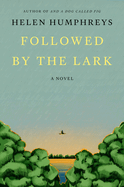
| Publisher: | Farrar, Straus and Giroux | |
| Genre: | Nature & the Environment, General, Biographical, Fiction, Historical | |
| ISBN: | 9780374611491 | |
| Pub Date: | February 2024 | |
| Price: | $27 |
| Starred | Fiction |
by Helen Humphreys
Henry David Thoreau lurks in English lit syllabi like a formidable giant, one to be emulated, revered, or perhaps even ridiculed. In Followed by the Lark, Helen Humphreys (And a Dog Called Fig) humanizes this great man through a series of vignettes starting when Thoreau is five years old and first sees Walden, which was "the first pond he'd ever known, so it might as well have been the wild ocean."
Humphreys, drawing upon Thoreau's extensive journals, crafts a novel of his life, showing the hurts, isolations, and uncertainties behind the spirit of awe that has inspired so many to attempt to live simply and deliberately. By gathering brief scenes into sections grouped chronologically, Humphreys escorts readers from the early years, including when Thoreau befriends Charles Wheeler and meets the influential Ralph Waldo Emerson, and through the season colored by the untimely deaths of both Thoreau's brother, John, and Charles. These losses inspire him to build his house on Walden Pond and to stay true to his belief that all life, no matter how small, is sacred. To him, "a detail was never impersonal--whether remembered or recorded. Paying attention was a kind of devotion, and he didn't need to write the words Love or Grief to prove his tenderness."
Humphreys's novel is full of these small details, reflecting Thoreau's commitment to observation. Those already familiar with Thoreau's life; fans of Robin Wall Kimmerer or Mary Oliver; and anyone who agrees with Thoreau that "[w]ondering didn't always need an answer" will all appreciate Followed by the Lark. --Sara Beth West, freelance reviewer and librarian
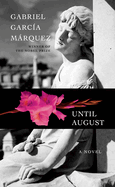
| Publisher: | Knopf | |
| Genre: | Women, Family Life, Literary, Marriage & Divorce, Fiction | |
| ISBN: | 9780593801994 | |
| Pub Date: | March 2024 | |
| Price: | $22 |
| Fiction |
by Gabriel García Márquez, trans. by Anne McLean
Although the Nobel Prize-winning author of One Hundred Years of Solitude may have abandoned Until August before proclaiming it finished, Gabriel García Márquez's fans will note many of the brilliant elements characteristic of his oeuvre.
His mastery of the opening sentence, for instance: "She returned to the island on Friday, August 16, on the three o'clock ferry." García Márquez thus establishes Ana Magdalena Bach's annual visit to place flowers upon her mother's grave on the anniversary of her death eight years ago. Every year, she takes the same ferry, travels in the same taxi, stays at the same hotel, buys gladioli from the same florist. But this year, she will invite a man up to her room.
García Márquez skillfully captures the salient details in a single phrase: "All of a sudden, like a fatal flash, she was struck by the brutal awareness that, for the first time in her life, she had fornicated and spent the night with a man who was not her own." The outsides mirror Ana Magdalena's insides at the mainland's port: the buildings "seemed alien and rotted by the salty sea air." She and her husband of 27 years enjoy a very active and loving sex life. But now, suspicions about fidelity come to the fore.
With a startling yet perfect ending, Until August is a provocative meditation about the ongoing assessment in any longtime intimate relationship--whether committed partners or parents and children. It is a treasured final gift from a beloved author. --Jennifer M. Brown, reviewer

| Publisher: | Random House | |
| Genre: | Women, Family Life, General, Literary, Fiction | |
| ISBN: | 9780593229804 | |
| Pub Date: | February 2024 | |
| Price: | $30 |
| Fiction |
by Anna Quindlen
Annie Brown's sudden death--"right before dinner," with the mashed potatoes "still in the pot on the stove"--is an unimaginable loss. In After Annie, Anna Quindlen (Nanaville; Alternate Sides; Miller's Valley) wields her trademark tender observations of the minutiae of life's joys and sorrows to reveal that what Annie leaves behind in the hearts and minds of her loved ones will be theirs forever.
The novel transpires over the course of a year, from the February day when Annie, in her 30s, dies of an aneurysm to the day her husband, Bill, their four children, and her best friend, Annemarie, visit Annie's grave on the anniversary of her death. Alternating chapters follow Bill, facing "a future that felt like a betrayal"; Annemarie, half of the duo of "the two Annes" since first grade; and Ali, the oldest child and only daughter, determined to maintain a sense of family for her three young brothers. When Ali speaks, her father notes "a grown woman coming out of her thirteen-year-old mouth." Their stories intermingle, emphasizing the ways Annie's encompassing affection touched their lives. Memories of Annie keep her alive on every page: she is the wise, loving, and funny heart of her family and community. Bill hears her "clear as water" or "as though she were sitting next to him on the couch."
Ali faces a disturbing realization about her best friend's family, and Annemarie is drawn back to the drug use that Annie's firm support helped her overcome. Both hear Annie's guidance: " 'You can do this,' said that familiar voice." Readers, too, feel Annie's comforting presence, balancing the heartbreak that this poignant novel evokes. --Cheryl McKeon, Book House of Stuyvesant Plaza, Albany, N.Y.
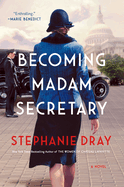
| Publisher: | Berkley | |
| Genre: | Women, General, Biographical, Fiction, Historical | |
| ISBN: | 9780593437056 | |
| Pub Date: | March 2024 | |
| Price: | $29 |
| Fiction |
by Stephanie Dray
Stephanie Dray brings Frances Perkins (1880-1965), U.S. Secretary of Labor and a fierce advocate for workers' rights, to vivid life in yet another gripping historical novel, Becoming Madam Secretary. Told in Perkins's sharp, no-nonsense, compassionate voice, the novel, set against the tumultuous backdrop of early 20th-century American politics, traces her career in social work and public policy.
Dray (The Women of Chateau Lafayette) charts Perkins's course from her work with the poor in Hell's Kitchen (where she befriended Tammany Hall bosses) to her roles as a lobbyist, professor, and advocate for better labor practices. Perkins was present for many events that shaped U.S. policy and politics during her career, including the devastating Triangle Shirtwaist Factory Fire and the political rise of Franklin Delano Roosevelt. But Dray also humanizes her narrator. Perkins is a brilliant intellect who becomes the architect of Social Security and the first female Secretary of Labor; she also is a loyal friend, a devoted wife and mother, and a woman determined to change workers' lives for the better. Dray depicts Perkins's complicated relationship with Roosevelt, marked by contention but also respect, as Roosevelt relied on Frances's political acumen and staunch resolve. As she watches her country suffer during the Great Depression, Frances takes up her pen to draft a New Deal, hoping its implementation will have lasting implications for all Americans.
Becoming Madam Secretary, powerfully told and rich with historical detail, is a nuanced portrait of a brilliant woman and her triumphs in the face of staggering challenges. --Katie Noah Gibson, blogger at Cakes, Tea and Dreams
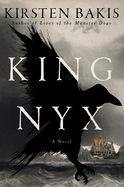
| Publisher: | Liveright | |
| Genre: | Occult & Supernatural, Mystery & Detective, Literary, 20th Century - General, Fiction, Historical | |
| ISBN: | 9781324093534 | |
| Pub Date: | February 2024 | |
| Price: | $28.99 |
| Fiction |
by Kirsten Bakis
Creepy forests, missing girls, eerie dolls, and unexplainable phenomena populate King Nyx by Kirsten Bakis (Lives of the Monster Dogs), a hypnotic feminist fantasy featuring the real-life figures Anna and Charles Fort. It is November 1918, and self-described "crypto-scientist" Charles and his wife, Anna, debark on Prosper Island at the invitation of millionaire Claude Arkel--an admirer of Charles's eccentric study of meteorological anomalies that science cannot explain (fish, eels, and even blood falling from the sky). Arkel invites them to stay on his private estate for the winter so that Charles can finish writing his magnum opus of oddities.
Narrator Anna, however, is uneasy after learning three local girls at the Arkel School for Domestic Service on the island are missing. Painful memories of her own life in service to Charles's abusive father--and the startling vision of a long-lost friend in the island's forest--force Anna into a dangerous reckoning with reality and sanity. Bakis's focus on female friendship is a bracing tonic, especially with the addition of Anna's hard-drinking fellow guest Stella Bixby, who takes Anna's quest to find the lost girls seriously. (Their husbands are of no help in this or any other regard.) As the mysteries of Prosper Island multiply and her repressed memories return, Anna realizes the "deeper you go, the stranger and uglier the monsters." Although the climax is somewhat implausible, Bakis's gothic journey, rendered in mellifluous and dreamy prose, will keep readers turning pages long past midnight. --Peggy Kurkowski, book reviewer and copywriter in Denver
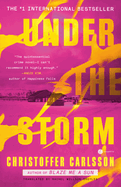
| Publisher: | Hogarth | |
| Genre: | Police Procedural, Mystery & Detective, Coming of Age, Fiction | |
| ISBN: | 9780593449387 | |
| Pub Date: | February 2024 | |
| Price: | $19 |
| Mystery & Thriller |
by Christoffer Carlsson, trans. by Rachel Willson-Broyles
Under the Storm is a powerful suspense novel from criminologist and Swedish crime writer Christoffer Carlsson (Blaze Me a Sun), skillfully translated by Rachel Willson-Broyles.
A house burns to the ground in Marbäck, a rural village in Sweden, and a body is discovered in the wreckage. The authorities and community believe that the victim, a local young woman named Lovisa, was murdered by her boyfriend, Edvard, despite a number of confounding indications to the contrary. In a town where everyone has known each other's families for generations, it's easy to assume that criminality and violence are genetic.
Young Isak assumes that he is tainted with the same violence as his beloved uncle Edvard, who now sits in prison for Lovisa's murder. The members of his community presume the same thing, which has a warping impact on the direction of Isak's life and his connections with other people. But holes in the case, along with the fact that Edvard has never confessed to the murder, nag at local police detective Vidar Jörgensson, who continues to pursue the case at great personal and professional cost.
No one is eager to revisit a long-closed murder case and reopen old wounds. The villagers tell themselves that "[a]s long as you know what to watch out for, life is pretty simple," even as hurricanes and tsunamis literally tear up the world around them. In its search for the truth, Under the Storm is an understated, tense, and psychologically alluring mystery. --Elizabeth DeNoma, executive editor, DeNoma Literary Services, Seattle, Wash.

| Publisher: | Open Road Media | |
| Genre: | Psychological, Police Procedural, Mystery & Detective, Literary, Suspense, Thrillers, Fiction | |
| ISBN: | 9781504084109 | |
| Pub Date: | March 2024 | |
| Price: | $19.99 |
| Mystery & Thriller |
by Mary McGarry Morris
One character is completely out of control in Mary McGarry Morris's thriller The Silence. As someone puts it, "I'm being harassed, tormented, stalked by a crazy person. A madwoman." Those may be villainous qualities, but the "madwoman" is actually a police officer, and the closest thing Morris's consuming novel has to a hero.
Ruth Corrigan, who grew up in Craigville, Mass., has never gotten over the death of her best friend, Ceely Pardeau, when they were eight. Ceely was found murdered in the woods where she and Ruth had been playing until Ruth left her there alone. Ruth suspects that the killer was the town priest, Father Phil, who she knew was molesting Ceely and whom the girls saw by the woods the day Ceely died. In the present, Ruth is a Craigville cop with an alcohol problem. On the night she learns that Father Phil has moved back to town, a sozzled Ruth is in a hit-and-run in a police cruiser. She decides to spend her suspension researching Ceely's murder.
The novel's perspective roves, but this is Ruth's story, and she gets a fantastic workup from Morris, who gives her speech patterns that reflect a fragmenting mind ("Can't seem to concentrate. Racing thoughts and pounding heart"). The ending of The Silence verges on melodrama, but Morris (Songs in Ordinary Time) delivers something richer than a typical procedural by teasing moral questions: Is lying for the common good okay? And must one always prize the common good over personal happiness? --Nell Beram, author and freelance writer
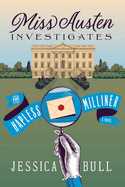
| Publisher: | Union Square & Co. | |
| Genre: | Women, Historical - Regency, Mystery & Detective, Romance, Fiction, Women Sleuths | |
| ISBN: | 9781454951803 | |
| Pub Date: | February 2024 | |
| Price: | $18.99 |
| Mystery & Thriller |
by Jessica Bull
In Jessica Bull's delightful Miss Austen Investigates: The Hapless Milliner, young Jane Austen is dallying at a ball with handsome Tom Lefroy until things are thrown into an uproar by the discovery of a body. Jessica Bull's first novel, which captures the real Jane's wit and liveliness, is a charming historical mystery sure to appeal to mystery readers and Austen lovers alike.
Jane is shocked when she recognizes the dead woman, a milliner from whom she recently bought a hat, but doesn't think much more about it--until the dead woman's necklace winds up in the possession of Georgy, her disabled brother. Because he is nonverbal, Georgy is unable to defend himself, and the Austens are cast into an uproar when the magistrate and constable arrest him for the crime. Much to the indignation of her other brothers, Jane decides to investigate the crime herself, given that the local magistrate considers the case already closed.
Snarky, clever Jane pokes into her neighbor's closets looking for skeletons, determined to free Georgy from prison. Jane questions everyone--chambermaids, farm workers--and finds clues that include a clandestine kiss and lending library records. Though the truths she has uncovered seem to point to any number of people, Jane is sure she must be near to uncovering the murderer when she discovers surprising items being left on the dead woman's grave. Full of twists and turns, Miss Austen Investigates: The Hapless Milliner is a fantastic historical mystery with a truly engaging protagonist at its center. --Jessica Howard, freelance book reviewer

| Publisher: | Minotaur | |
| Genre: | Police Procedural, Mystery & Detective, Fiction, Women Sleuths | |
| ISBN: | 9781250865441 | |
| Pub Date: | February 2024 | |
| Price: | $28 |
| Mystery & Thriller |
by Kelley Armstrong
An isolated village designed to offer protection to those needing to disappear can be a paradise or a prison, as Kelley Armstrong (The Deepest of Secrets; Wherever She Goes) explores in the engrossing The Boy Who Cried Bear. Married couple Sheriff Eric Dalton and Detective Casey Duncan manage Haven's Rock. It's a sanctuary deep in the Yukon for carefully vetted residents: some have been criminals and others, victims of violence. All of them seek a safe place, and many assume fake names to shed their previous lives. The dense woods mask the closeness of wildlife and other settlements, such as a nearby mining operation.
The Boy Who Cried Bear skillfully melds a village mystery with a high adventure and acutely explores its numerous characters. The heart of the story is two brothers: teenager Carson and 10-year-old Max, who arrived with their mother, Dana, and are the first children at Haven's Rock. They are full of guilt and grief after having just seen their mother injured and their father killed while in witness protection. Their ennui at being forced to a remote area mirrors the adults' restlessness.
During a group hike, Max believes a bear with "human eyes" is stalking them. Mindful of the village's safety, Casey and Eric organize a hunt. The urgency to find the bear accelerates when one of the children is kidnapped and a murder occurs in the forest. Sightings of a man dressed in a bearskin add to residents' fears that the outside world is intruding. The Boy Who Cried Bear illustrates how easily a civilized society can succumb to the wilderness. --Oline H. Cogdill, freelance reviewer
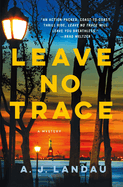
| Publisher: | Minotaur | |
| Genre: | Suspense, Thrillers, Fiction | |
| ISBN: | 9781250877338 | |
| Pub Date: | February 2024 | |
| Price: | $28 |
| Mystery & Thriller |
by A.J. Landau
Leave No Trace, A.J. Landau's debut, begins with the astonishing explosion of the Statue of Liberty, which kills more than 700 people and seriously injures hundreds more. In this series launch, Landau follows this heart-in-throat scene with nonstop action that allows for close attention to the solid characters.
Michael Walker, a special agent with the National Parks Service, and Gina Delgado, an FBI explosives expert, are among the first on the scene. This leads to the usual jurisdiction conflicts, exacerbated because Michael lacks high-level security clearance. There appear to be no clues as to who may be responsible. Then Michael finds a survivor, Danny Logan, a 15-year-old whose fascination with boats prompted him to capture video of a park police boat that likely had the terrorists aboard. Michael and Gina form a partnership that is at first hampered by rivalry between their agencies. A mutual respect soon grows as their individual skills lead them to a group out to destroy American landmarks.
Landau, a pseudonym for authors Jon Land and Jeff Ayers, invests the elaborate plot of Leave No Trace with insider views of several sites, such as the Gateway Arch in St. Louis and, in a tense finale, South Dakota's Wind Cave. Realistic suspense permeates each chapter, including an uneasy scene in a hospital as Michael tries to protect Danny, and the parallel investigation of Lantry, a Lakota Sioux man who's also tracking the terrorists. The back stories of Michael and Gina add heft to Leave No Trace--and leave room for a much-needed sequel. --Oline H. Cogdill, freelance reviewer
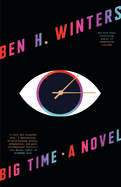
| Publisher: | Mulholland Books | |
| Genre: | Espionage, Crime & Mystery, Coming of Age, Thrillers, Fiction, Science Fiction | |
| ISBN: | 9780316305778 | |
| Pub Date: | March 2024 | |
| Price: | $29 |
| Science Fiction & Fantasy |
by Ben H. Winters
In the inventive science fiction thriller Big Time by Ben H. Winters (The Last Policeman, Golden State), a woman wakes in a hospital bed after an abduction with what seem to be two sets of memories, and a Food and Drug Administration bureaucrat takes on a shocking conspiracy.
Before she regained consciousness in the hospital, Allie had escaped from the woman who had abducted her. She had tried desperately to call her husband, wondering what had happened to her baby from whom she was separated--except she also remembers never having married or had children.
Grace Berney works at the FDA, where she is asked to come in after hours to investigate an unusual portacath in a hospital patient, hoping it will help to identify her. When work begins in the morning, the patient, Allie, is gone, and the request has been dropped. But Grace can't let go of the suspicion that someone used her for some unspeakable purpose.
In most of Winters's speculative fiction, set in worlds clearly distinct from our own (such as in Underground Airlines, set in a U.S. in which the Civil War never occurred), his ability to make the setting feel real through small details draws in readers. Big Time proves his talent remains just as strong when the speculative premise is unknown until nearly the end: Winters slowly feeds information to both characters and readers alike through a high-stakes pursuit for information while Allie runs from abductors. Readers will remain enthralled even past the last pages, as the epilogue leaves ominous implications. --Kristen Allen-Vogel, information services librarian at Dayton Metro Library
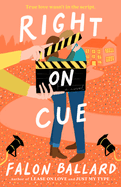
| Publisher: | Putnam | |
| Genre: | Women, Romantic Comedy, Romance, Fiction | |
| ISBN: | 9780593712900 | |
| Pub Date: | February 2024 | |
| Price: | $18 |
| Romance |
by Falon Ballard
Right on Cue by Falon Ballard (Just My Type), about a perfectly staged rom-com that turns into an imperfectly authentic one, brims with delectable chemistry and irresistible enemies-to-lovers banter.
Emmy Harper is the offspring of two Hollywood legends and, inspired by her parents' love story, has written some of the most popular romantic comedies in the industry. After taking a break following her father's death, she returns to rom-com writing and pens an amazing script. Liz, her best friend and an award-winning director, is on the project. The only thing missing is a leading lady. Thus, Emmy begrudgingly agrees to star in her own movie. Pine Springs, Calif., the filming location for No Reservations, is Hallmark movie-level perfect--until Emmy runs into her last-minute replacement co-star, Grayson West. "Grayson fucking West," as Emmy calls him, is the "action hunk" who was her first co-star. Teenage tension and a failed onscreen kiss cemented the failure of her first (and only) acting role.
The pages of Right on Cue are buzzing with exhilarating chemistry and unceasing witty banter. Emmy's entertaining annoyance with Grayson and his feigned, uncaring attitude work to create a pair as seemingly unsuited on screen as they are in real life. The two give into their growing tension and discover it may just save the movie. Sparks fly and scenes are re-filmed as the two go from enemies to co-stars "with benefits"--and then to something even more. --Clara Newton, freelance reviewer

| Publisher: | Simon Element | |
| Genre: | Ayurveda, Cooking, Nutrition, Vegetarian, Body, Mind & Spirit, Health & Fitness, Diet & Nutrition, Vegan | |
| ISBN: | 9781982199722 | |
| Pub Date: | February 2024 | |
| Price: | $35 |
| Food & Wine |
by Radhi Devlukia-Shetty
It's not often that the word incandescent is used to describe a cookbook, but one look through JoyFull will reveal why it's the perfect description for this one. JoyFull: Cook Effortlessly, Eat Freely, Live Radiantly, the debut by self-taught cook and nutritionist Radhi Devlukia-Shetty, reflects the effervescent personality of its author while delivering more than 125 delicious and nourishing plant-based recipes.
"What you eat--along with your daily habits and the thoughts you think--has the ability to completely transform every aspect of your health," Devlukia-Shetty writes. JoyFull is her love letter to these Ayurvedic principles. Each recipe is chosen to promote mindful and harmonious practices around food. Devlukia-Shetty also generously shares her own self-care routines for wellness.
The chapters in JoyFull are organized to promote a lifestyle that "honors and supports the 24-hour cycle of our bodies," starting with lighter morning meals; followed by heavier midday meals; and, finally, dishes near the end of the cookbook to "suit a body preparing for rest." The recipes--for main dishes, snacks, drinks, and sweet treats--are simultaneously nuanced, playful, and comforting. Tempting options include an Iced Matcha Tahini Latte, Chai Oatmeal, One-Pot Lemony Spaghetti, and Baklava Cheesecake.
Pulling from her Indian heritage, Devlukia-Shetty includes recipes that have been passed down through her family as well as those from places she's traveled to, making this a truly personal collection. Vibrant, beautiful photographs of family and food fill this cookbook and add to the immersive, evocative experience. --Grace Rajendran, freelance reviewer
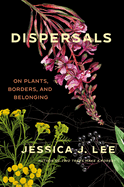
| Publisher: | Catapult | |
| Genre: | Biography & Autobiography, Nature, Trees, Human Geography, Asian & Asian American, Ecology, Plants, Memoirs, Social Science | |
| ISBN: | 9781646221783 | |
| Pub Date: | March 2024 | |
| Price: | $27 |
| Starred | Biography & Memoir |
by Jessica J. Lee
"Plants illuminate facets of life and our world," writes Jessica J. Lee in the introduction to her exquisite, haunting third book, Dispersals, a collection of essays examining the movement of people and plants. In 14 linked essays, Lee (Two Trees Make a Forest) explores the notion of "native" and "invasive" species; turns a zoom lens onto mosses and other tiny but powerful plants; and considers terms like rooted and migration in light of her own Welsh-Taiwanese-Canadian ancestry and her more recent moves across (and within) Europe and the U.K.
Lee begins with the koi pond her mother constructed in suburban Canada, her longing for her Taiwanese homeland made manifest in a backyard habitat for fish too fragile for Ontario winters. Lee describes her mother's dedication in loving detail, then steps back to consider movement and displacement: species of algae and reeds and water weeds, labeled "native" or "invasive" depending on where they take root. Through her experience as a mixed-race woman, her research into plants and their histories, and her longtime love for National Geographic, Lee also wrestles with complicated ideas about what it means to explore and to discover--and who gets to claim (and profit from) those discoveries.
The book's last essay, "Synonyms for Mauve," is a tender meditation on motherhood and Lee's intense need to create a safe, appealing home for her young daughter. "I am moving in search of beauty," she writes. Throughout Dispersals, Lee continues her insistent, clear-eyed quest for nourishment and vitality, even when both are complicated, and encourages readers to do the same. --Katie Noah Gibson, blogger at Cakes, Tea and Dreams

| Publisher: | Plume | |
| Genre: | Biography & Autobiography, Self-Help, Personal Growth, Gerontology, Fashion, Aging, General, Social Science | |
| ISBN: | 9780593471791 | |
| Pub Date: | March 2024 | |
| Price: | $28 |
| Starred | Biography & Memoir |
by Lyn Slater
In How to Be Old: Lessons in Living Boldly from the Accidental Icon, Lyn Slater genially chronicles not just one reinvention but two: her third-act transition from academic to fashion influencer, followed by her shift to becoming something else entirely.
Slater, a working-class child of New York, was a professor of social work when, on the cusp of age 60, she decided to study fashion. In 2014, at 61, she launched a fashion blog that caught fire. Slater appeared in an ad for Valentino eyewear, signed with a modeling agency, and was internationally feted as an older woman who wasn't trying to look young but nevertheless put in the work to look great. Slater's success eventually led to a crisis of conscience: "I wanted my life to have meaning. Posting photos of myself using beauty products on Instagram did not seem to rise to the occasion."
With a nudge from the pandemic, Slater and her partner left Manhattan for upstate New York. At the time that she's writing her book, Slater is nearing 70 and a dedicated gardener, grandmother, and upcycler. "The part of me that is Accidental Icon is not gone," she reassures readers. "I've just reinvented her again, exactly the way I did in 2014." This isn't typical celebrity-influencer fare: How to Be Old is more theoretical than confessional, as much self-help as memoir. The narrative can sometimes meander, but the writing is agile, the present tense a gentle spur to live in the moment, age be damned. --Nell Beram, author and freelance writer
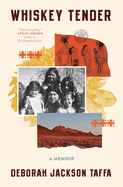
| Publisher: | Harper | |
| Genre: | Biography & Autobiography, Women, Indigenous, Memoirs | |
| ISBN: | 9780063288515 | |
| Pub Date: | February 2024 | |
| Price: | $30 |
| Biography & Memoir |
by Deborah Jackson Taffa
Deborah Jackson Taffa, director of the MFA in Creative Writing program at the Institute of American Indian Arts, interrogates her childhood both on and off the reservation in her unflinching memoir, Whiskey Tender.
Native memoirs are rare, she writes, for several reasons, one of which is the question of who has the right to speak. Questions of who speaks, which stories get told, and who tells them haunt the pages of this densely woven debut. Taffa spends her childhood beseeching her father for stories of their ancestors. It's a tough task, especially because their family's languages, Yuma and Keres, have been lost between generations and many of her ancestors died young.
Longing to find one's place in the world is well-trodden territory. But Taffa's quest is brutally complicated by her mixed heritage and her hostile surroundings. Not only must she contend with an oppressive outside world, vividly depicted in her Catholic and public school years, but also within her own family she struggles to find her place. She describes her father as admiring full-blooded Indians, while her Hispanic mother, raised as an obedient Catholic and one of 15 children, would rather Taffa pass as white. Taffa seeks Indigenous traditions while facing her mother's vehement disapproval.
Episodes from Taffa's childhood and family history are interspersed with tyrannous government policies enacted throughout the years against Native Americans. Whiskey Tender is both a survival story and a reckoning, as well as an ode to a family striving valiantly and tragically to gain footing in racist, hostile America. --Nina Semczuk, writer, editor, and illustrator

| Publisher: | Celadon | |
| Genre: | Biography & Autobiography, Women, Family & Relationships, Death, Grief, Bereavement, Asian & Asian American, Memoirs | |
| ISBN: | 9781250835048 | |
| Pub Date: | March 2024 | |
| Price: | $30 |
| Biography & Memoir |
by Susan Lieu
Susan Lieu had a distinct goal: "I wanted to publish this memoir when I was thirty-eight, the same age my mother was when she died from a tummy tuck." Lieu originally made her family tragedy public in 2019 in a sold-out one-woman theatrical show, 140 LBS: How Beauty Killed My Mother. In The Manicurist's Daughter, she alchemizes her live performances into print, fortifying it with all the background and backstories to produce a raw, mesmerizing look at paralyzing grief, immigrant identity, and familial dysfunction and redemption.
Lieu's parents, two older brothers, and older sister arrived in California in 1983 as "boat people." The family welcomed Susan, their only U.S.-born child, in 1985. Má founded two nail salons, earning enough to sponsor five relatives from Vietnam, whom she housed and employed. In 1996, Má went into surgery for a tummy tuck, nose work, and chin implant. She was deprived of oxygen for 14 minutes before the doctor called 911. She flatlined after a five-day coma. Má's death, Lieu would learn, "was the result of a negligent white man with a track record of preying on vulnerable Vietnamese refugees."
The extended family quickly imploded. The businesses faltered. Lieu spent decades chasing answers, trying to understand who Má was--her experiences, decisions, hopes, plans. Lieu lays bare her attempts to "reconstruct" and "resurrect" Má with tenacious honesty and vivid desperation, but also balances this with surprising humor and grace. Her revealing, chatty writing style proves both intimately confessional and undeniably inviting: her own "[s]eeking the truth" becomes rallying encouragement for readers to talk, share, explore, and ultimately forgive in order to live. --Terry Hong
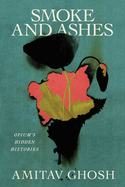
| Publisher: | Farrar, Straus and Giroux | |
| Genre: | Industries, Business & Economics, General | |
| ISBN: | 9780374602925 | |
| Pub Date: | February 2024 | |
| Price: | $32 |
| History |
by Amitav Ghosh
In this sweeping history, renowned novelist Amitav Ghosh (Gun Island; Flood of Fire; River of Smoke) brilliantly traces the impacts of the opium trade on India, China, and his own family. Smoke and Ashes is a deep dive into the history of colonialism and poppy production on the Indian subcontinent that is sure to interest those horrified by the opioid crisis, or intrigued by what historian Hans Derks termed the enduring "narco-character" of wars in Vietnam and Afghanistan.
By forcing Indians to grow opium at steeply subsidized rates and penalizing them if they failed to meet targets, the British soon had vast quantities of a very cheap, addictive substance on their hands, which they introduced to Chinese society, much as Purdue Pharma pushed OxyContin in the modern United States. As addiction claimed large swaths of Chinese society, the British watched the money roll in, uncaring about the effects of their criminal policies. Many British people--and Americans, including Franklin Delano Roosevelt's grandfather--became unbelievably wealthy in the opium trade, caring little about the cost to Indian and Chinese culture.
Those with long memories are sure to see the parallels between colonial policies during the opium years and China's currently pugnacious attitude toward the West. Unfortunately, as Smoke and Ashes makes clear, many have forgotten this, because "European empires have been astonishingly successful at whitewashing the historical record." However, a deeper understanding of the painful impact of colonialism is vital in order to foster any kind of contemporary reconciliation between China, India, and the West. --Jessica Howard, freelance book reviewer
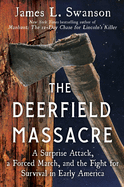
| Publisher: | Scribner | |
| Genre: | Colonial Period (1600-1775), United States, Indigenous, General, History, State & Local - New England (CT, MA, ME, NH, RI, VT) | |
| ISBN: | 9781501108167 | |
| Pub Date: | February 2024 | |
| Price: | $30 |
| History |
by James L. Swanson
The nightmarish ordeal of a remote early American outpost--and the efforts to preserve its history in the American consciousness--is the absorbing focus of The Deerfield Massacre by historian James L. Swanson (Chasing King's Killer; "The President Has Been Shot!"). On February 29, 1704, the roughly 300 residents of Deerfield, a wilderness outpost on the western edge of the Massachusetts colony, awoke to tomahawks hacking at their doors and flames consuming their homes. Approximately 250 Native warriors and their French allies slaughtered almost 50 townspeople and forced 112 captives back to Canada. This represented an "early volley in a larger war," known as Queen Anne's War, between the French and English. The raid's "great prize" included Deerfield's spiritual leader, Reverend John Williams, and most of his family.
Relying on Williams's published narrative of his captivity in "New France," Swanson imagines the thoughts and experiences of those who witnessed the deaths of loved ones or lost others to their assimilation into Native tribes. He takes a novel approach in the final third of the book as he follows Deerfield's story in American memory, illuminating the ways history is retold in each succeeding generation's various preservation efforts. It is an apt coda to a violent episode that has left a "holy relic": a massive hatchet-scarred door known as the Old Indian Door. The Deerfield Massacre is a fascinating and dramatic tale of a "long-lost America" whose afterlife still has something to say about faith, survival, and redemption. --Peggy Kurkowski, book reviewer and copywriter in Denver
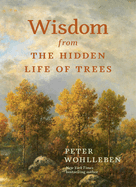
| Publisher: | Greystone | |
| Genre: | Nature, Trees, Self-Help, Personal Growth, Mindfulness & Meditation, Body, Mind & Spirit, General, Plants | |
| ISBN: | 9781778401404 | |
| Pub Date: | March 2024 | |
| Price: | $15.95 |
| Starred | Nature & Environment |
by Peter Wohlleben, trans. by Jane Billinghurst
A 9,550-year-old spruce in Sweden, the dwarf trees of Lapland in Finland, and so much more: Wisdom from the Hidden Life of Trees by Peter Wohlleben, translated from the German by Jane Billinghurst, revels in the everyday drama unfolding in forests as trees go about their business of enticing bees with scented blossoms, pumping water into land-locked areas, and sharing news with each other through a dense underground network referred to as the "wood wide web."
Wisdom from the Hidden Life of Trees is an enchanting, pocket-size collection of insightful gems lifted from Wohlleben's splendid international bestseller, The Hidden Life of Trees. The author, a world-renowned forester, runs a sustainable forest academy in Germany. The artwork accompanying his animated narrative is superb, inviting peaceful contemplation and, as with all great art, a more meaningful reflection of one's own place in the world. Celebrating the vitality of old trees, Wohlleben (The Weather Detective) explains how they are full of energy and highly productive, contributing to the health of their forest habitat despite their advanced age.
Readers curious to understand why urban tree roots encroach into pipes or why identical trees drop their leaves at different times--it's "a question of character," the author explains--will be fascinated by Wohlleben's insights.
Wisdom from the Hidden Life of Trees offers a restorative literary sojourn into the natural world and an invaluable understanding of the marvelous complexity of forests. As Wohlleben writes, after one flips through the pages of this wondrous little book, "a walk in the woods will never be the same again." --Shahina Piyarali
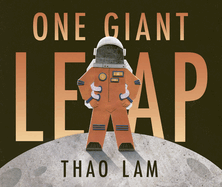
| Publisher: | Owlkids | |
| Genre: | Space Exploration, Imagination & Play, Juvenile Fiction, Action & Adventure, Science Fiction | |
| ISBN: | 9781771475990 | |
| Pub Date: | February 2024 | |
| Price: | $18.95 |
| Starred | Children's & Young Adult |
by Thao Lam
Plenty of picture books encourage young readers to go outside and have an adventure, but Thao Lam's wordless and wondrous One Giant Leap raises the bar by presenting an out-of-doors setting that's also out of this world--at least in the mind of one imaginative child.
The book begins with a kid suiting up to go out in the cold: snowsuit, boots, gloves, hat. With a tweak of the child's imagination, the ensemble becomes a space suit. Once outside, the kid weightlessly bounces across an uninhabited planet (that may really be a deserted city); plants a flag after climbing a space mountain (that may really be some sort of urban edifice); and faces three muscle-bound aliens (who may really be children in bulky snowsuits). Finally, the child, seeking a space ride home, reaches a door and enters... a classroom (that's really a classroom). It's occupied by three kids, whose "alien" apparel (snowsuits) can be spotted on wall hooks.
Lam's cut-paper collage art is reproduced so vividly that readers may half expect to be able to move the images around like tangram pieces. As in all wordless picture books, the art is doing double duty, pleasing the eye and telling the story, but Lam (Happy Birthday to Me) also executes the occasional visual trick. In one showstopper, readers see what the space-suited child sees--six blocky shapes lined up on the ground--until a facing panel from a different perspective makes clear that the shapes are actually the three not-really-aliens' space-booted feet. --Nell Beram, freelance writer and YA author
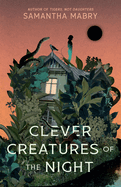
| Publisher: | Algonquin Young Readers | |
| Genre: | Psychological, Friendship, Horror, Magical Realism, Thrillers & Suspense, Social Themes, Young Adult Fiction, Diversity & Multicultural | |
| ISBN: | 9781616208974 | |
| Pub Date: | March 2024 | |
| Price: | $18.99 |
| Starred | Children's & Young Adult |
by Samantha Mabry
Samantha Mabry (Tigers, Not Daughters) deftly blends psychological horror and magical realism in this engrossing, deeply unsettling YA novel about how a teen girl's efforts to find her friend are stymied by the missing girl's disconcerting young housemates.
High school graduate Case has returned to the Texas county where she grew up to visit her best friend, Drea. When Case arrives at the ancient, ivy-covered house, tucked deep in the forest, where Drea has been living with a group of young people, however, Drea is missing. The young woman's housemates claim with a specious aloofness that they don't know where she went and won't explain why all of Drea's stuff is gone. Case, stuck without a car or cell reception in a place she loves yet always believed would destroy her, searches for answers in Drea's hidden journal entries and in her woodland hideaway. Each maddening clue--Drea's burnt notebook, her cryptic stories hinting at a rising tension in the house--fuels Case's suspicion about Drea's housemates.
Clever Creatures of the Night pulls taut across a single day of terse conversations, uncovered lies, and violent moments. Case's acerbic, comedic, and compelling third-person narrative is strengthened by her complexities, such as surviving a house fire that has left her nerves misfiring. Mabry's sentences sing, shaping a sinister and surreal setting marked by abnormally wild creatures and an off-kilter house. An unnerving yet addictive foreboding underlies every moment of this gritty read-in-one-sitting mystery. --Samantha Zaboski, freelance editor and reviewer
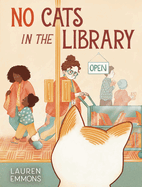
| Publisher: | Paula Wiseman Books | |
| Genre: | Cats, Emotions & Feelings, Animals, Social Themes, Books & Libraries, Juvenile Fiction | |
| ISBN: | 9781665933681 | |
| Pub Date: | March 2024 | |
| Price: | $18.99 |
| Children's & Young Adult |
by Lauren Emmons
Clarisse, a stray cat who loves books, encounters a significant problem when she sneaks into the library: cats are not allowed. The shrewd little feline wriggles her way into the hearts of readers as she attempts to outsmart the rule-enforcing librarian in Lauren Emmons's endearing picture book.
When Clarisse discovers a "magical building where people walked in empty-handed and came back out with books," she attempts to simply walk in. But the "keeper of the books" puts her right back out. Then she tries hiding in a child's bag, which also proves unsuccessful. The determined cat finally discovers a way past the librarian--through the book drop--and wanders into the stacks. There she encounters a struggling young reader who is encouraged by Clarisse's presence. The two make a perfect pair: Clarisse is a patient, rapt audience for the girl who makes the stories come alive; the girl's no-judgment audience transforms reading from a struggle to a joy. And, best of all, the librarian decides, "read-aloud cats are welcome in the library!"
Emmons, who illustrated Donna L. Washington's Prak Fills the House, makes her authorial debut with this heartwarming tale. The author fills her appealing library setting with expressive characters and uses warm, inviting colors and speech bubbles to add playfulness to the already cheerful atmosphere. Clarisse is an especially endearing protagonist as she adorably tumbles down the book drop chute or snoozes contentedly on a book cart. No Cats in the Library is part adventure, part encouragement, and all delightful. --Jen Forbus, freelancer
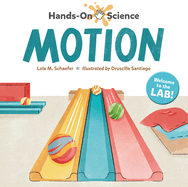
| Publisher: | Charlesbridge | |
| Genre: | Activity Books, General, Science & Nature, Juvenile Nonfiction, Physics | |
| ISBN: | 9781623542450 | |
| Pub Date: | February 2024 | |
| Price: | $16.99 |
| Children's & Young Adult |
by Lola M. Schaefer, illust. by Druscilla Santiago
Like Hervé Tullet's wildly popular Press Here, the fun, informative, and visually pleasing Hands-On Science series of picture books relies on readers using their imagination to grapple with concepts like geology, matter, and, in this case, motion.
Former classroom teacher Lola M. Schaefer (Lift, Mix, Fling!) is a fan of kids applying their creative faculties to learn about science. In Hands-On Science: Motion, she introduces early physics concepts including force, gravity, and friction through simple experiments. Readers touch illustrations of whipped cream, blow on piles of sand, and tilt the book to make a marble roll down the page. Unlike classic touch-and-feel books like Pat the Bunny, though, the tactile sensations are imagined. ("Sand flew everywhere! What a mess!") Using a mix of playful words ("Bonk!", "Whoosh!") and clear instructions, Schaefer invites readers to interact with the pages. After giving a blob of whipped cream a "poke" and seeing how the force of the finger changes its shape, readers are encouraged to turn the book upside down and shake it: "Uh-oh!... Gravity pulled the cream off the page and onto the floor. Gravity is a force that pulls objects toward Earth."
Hands-On Science series illustrator Druscilla Santiago's uncluttered digital art uses pastel backdrops and plenty of white space to depict items both at rest and interacting with the different forces. Santiago's crisp lines, paired with Schaefer's uncomplicated descriptions, ensure that readers will see how they "create forces every moment of every day." --Emilie Coulter, freelance writer and editor